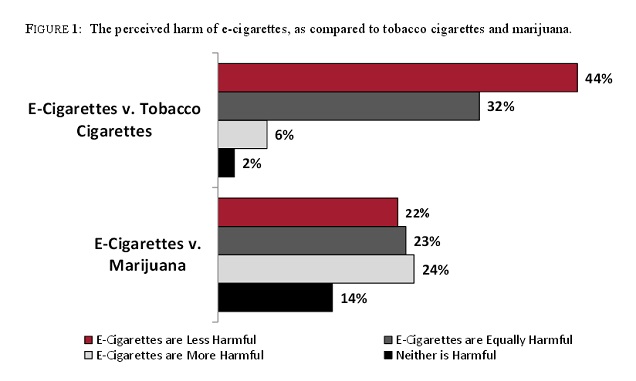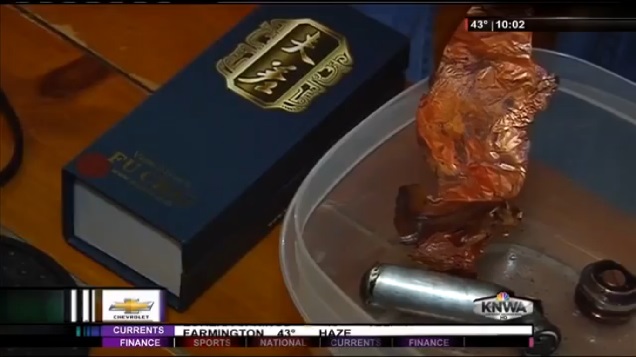
Another week, and more of the usual in the world of vaping. The public overestimates the risks of e-cigarettes, moves to ban indoor vaping continue in many localities and even in public housing units, misused mechanical mods explode, countries grapple with how to regulate e-cigs and the onslaught of anti-vaping nonsense continues, with claims that e-cig companies are intentionally marketing to youth, and that this is backed up by research (it isn’t). So, here’s the Week in Vaping.
E-Cigarette Research
A telephone survey of US adults has found that 65 percent think that e-cigarettes are harmful to users, less than the number saying tobacco is harmful (thankfully) but more so than marijuana (puzzlingly). The survey results reveal the shocking ignorance of the public on the risks of vaping. Only 44 percent correctly responded that e-cigarettes were less harmful than cigarettes, with 32 percent saying they’re equally harmful and 6 percent saying they’re more harmful to health.

Greg Conley commented:
Let’s be clear — there is no doubt in the scientific community that vaping is far less hazardous than inhaling burning tobacco smoke. The fact that more than half of the American population can’t answer this question accurately is a scandal.
The public health establishment should be called to task for their role in misinforming Americans about these reduced harm technology products.
Also, 64 percent also say e-cigs should be taxed like cigarettes, and 61 percent think TV ads should be banned. Additionally 69 percent support indoor vaping bans and about half think that flavors should be banned (because, “won’t somebody please think of the children!”).
A new study is reported as finding that adolescent vaping is tied to breathing problems, based on a survey of over 45,000 children in Hong Kong. The likelihood of “respiratory symptoms” among never-smokers who’d vaped (just 0.1 percent of never-smokers) was double that for those who’d never vaped, but among ever-smokers or ex-smokers, the odds of having such symptoms were just 40 percent higher in those who’d vaped. For current smokers, there was no significant difference in respiratory symptoms between vapers and non-vapers.
However, since “respiratory symptoms” were defined as coughing or phlegm – coughing being a common side-effect of vaping – it’s kind of obvious that never-smokers starting to vape would experience this more than smokers starting to vape. If an adolescent vaped at some point in three consecutive months, and coughed when he or she vaped, this would class as “respiratory symptoms.” Does that equate to “breathing problems” in the way the media suggests?
Legislation, Regulation and Vaping Bans

After last weeks’ raids on Malaysian vape stores, the Health Ministry has set up a special committee to deal with issues associated with e-cigarettes, but it was also clarified that under existing laws, only pharmacists and medical practitioners can sell nicotine e-liquids. Additionally, the Youth and Sports Minister criticized the raids as “rash”, and the Deputy Health Minister said that the action was “drastic” and vape stores should be given more time to legalize their business. Malaysia is looking into new laws to cover vaping specifically, rather than relying on the (obviously inappropriate) Poisons Act.
Ingham County in Michigan has approved legislation designed to reduce youth access to e-cigarettes, banning sales to minors and requiring stores selling vaping products to get a license. Stores already selling cigarettes don’t have to re-apply, but e-cig only stores will need to obtain one.
Cook County, Illinois has proposed a 20 cent per ml tax on e-juice, which has (obviously) annoyed owners of vape stores, who point out that it would raise the price to about as much as you’d pay for a pack of cigarettes. It would raise the price of a 30 ml bottle by $6, or a 15 ml bottle by $3.
Snohomish County, Washington has voted to ban vaping in public places – anywhere smoking is banned, including within 25 feet of doorways, in employee vehicles, in 75 percent of more of hotel rooms, and in outdoor venues and workspaces connected to a business where employees work – as well as banning their sale to minors. Vape stores (which only sell vaping products) can still have vaping indoors, if they have an independent ventilation system.
The Board of Health in Pierce County, Washington will vote next week on regulations that aim to ban vaping in public places and ban possession of e-cigarettes by under 18s (selling to them is already illegal). Vape stores will also have get a permit (costing around $375) to continue selling vaping products.
The FDA has granted Swedish Match permission to market eight new snus products in the U.S., indicating that they successfully demonstrated that the products are “beneficial to the population as a whole including users and non-users.” This is the first time a new tobacco product has received such approval through the premarket authorization channel. Swedish Match has also filed a modified risk tobacco product application, but no decision has been reached on this yet. Carl V. Phillips and Michael Siegel also have posts about the latest decision that are worth checking out.
The Department of Housing and Urban Development is considering banning the 1.2 million American households in public housing units from smoking indoors, and now they’re threatening to include e-cigs in the rule too. The Smoke Free Alternatives Trade Association has released a statement about the proposed rule, and it’s been pointed out that the move would affect the disabled most of all.
Vaping Related News, Blog Posts and Other Stuff

Another e-cig explosion has hit the news, this time an Arkansas man who was trying to quit smoking using a mechanical mod. His mouth, throat and hand were burned, his teeth shattered and his lips severed. The story is obviously being used to drum up more fear of e-cigarettes, but the real message is undoubtedly a warning to new vapers not to use mechanical mods without a capable battery and a thorough understanding of battery safety.
A vaping expo in New Orleans ran into problems when officers from the Department of Revenue came in and demanded that exhibitors pay tax on free samples they were offering.
Brad Rodu has some words of wisdom on the diacetyl and acetyl propionyl issue, pointing out that Dr. Farsalinos’ study should have prompted mixers to stop using them and stores to stop selling them, but the recent Milwaukee Journal Sentinel report shows that they have not. He says vapers should avoid both chemicals.
Simon Chapman has written a blog post for the BMJ criticizing Clive Bates’ position on e-cigarettes and youth today in contrast to his position on cigarettes and youth as stated in 2000. To Chapman, this is “walking on both sides of the street,” but to anybody with a functioning brain they are two separate issues which shouldn’t elicit identical opinions. Clive Bates reproduces his response to the criticism in the comments in a blog post.
The Ashtray Blog has a nice summary of the third annual E-Cig Summit in London, with some brief notes on all of the talks and some choice quotes from the speakers – well worth checking out if you want to know what happened. There’s also a nice summary of the event by Paul Barnes on Facts Do Matter.
Action on Consumer Choice also has a brief post addressing the Summit, but it’s more generally about vaping as they didn’t attend.
Another post on the Ashtray Blog (from ECR’s Lee Johnson) offers some useful tips for smokers who’ve struggled to make the switch to vaping.
Another Facts Do Matter post addresses the relationship between vapers and smokers, rightfully pointing out that the vaping community should work with smokers, which is well worth reading.
VapourLites offers a brief rundown of six useful vaping apps.
Bullshit of the Week: Some E-Cigarettes “Are Purchased Mainly by Children”

The German Cancer Research Center’s Martina Pötschke-Langer has proven herself to be a veritable fountain off bullshit this week, rattling off the typical anti-vaping claims along with others so bold and unsubstantiated that it’s hard to come up with a description other than “blatant lying.”
For example:
The product range is great and also very appealing to children. Some of these products are purchased mainly by children.
Yes, she’s saying that some e-cigarettes are mainly purchased by children. Never mind the fact that there’s no evidence whatsoever to support this statement, and even a simple comparison of the spending power of adults vs. that of children pushes it so far into the realms of absurdity that it can’t even be rescued.
The reason, according to Martina, is that they’re specifically targeted at children:
The marketing is definitely geared towards youngsters, especially because children like the flavors, like bubble gum. […] Producers have used unscrupulous strategies to build up a market made up of children and adolescents. That was intentional and we have studies on the subject.
“We have studies on the subject,” is clearly some sort of bad joke. If there was a study showing that e-cigarette manufacturers purposefully targeted youth with their marketing we’d never hear the end of it. Of course, no reference is provided (no prizes for guessing why).
Dick Puddlecote annihilates this argument with a mock-discussion that may have (read: definitely hasn’t) gone on in the board-room of an e-cig company:
Evil E-Cig Exec: We need to sell as many of these as possible, how do we go about it?
Henchman: Well, there are tens of millions of adult smokers in Europe and many more around the world we can reach via the internet. Tobacco control say that 70% of them are desperate to quit smoking so it is a huge and willing market to tap.
EEE: How easy would it be to sell to these adult smokers?
H: A doddle. They already spend massive sums of cash on cigarettes due to taxation, so they would actually be saving money buying our products instead. We would also be seen as the good guys for helping them quit tobacco. It's win/win all round.
EEE: Nah, fuck adults and all their cash, let's sell to kids instead. They have next to no disposable income, have no natural need for the product and are almost impossible to advertise to, that's much more likely to turn a profit. Plus I like scandalising the public, it's all I'm in the game for.
H: Yes, good point, why didn't I think of that before, Master?
Said no e-cig company board members, ever.
The original article carries on in the same vein, but it’s such transparent nonsense – and well-covered by Puddlecote – that it can be safely left to float there and ruin the German Cancer Research Center’s reputation on it’s own, like an un-flushable turd scaring people away from a toilet cubicle.
That’s It! Check Back Next Week for More
If we’ve missed an important story, let us know in the comments! If not, check back next week for another update of what’s been going on in the world of vaping. We’ll have some good news one week… we hope.

